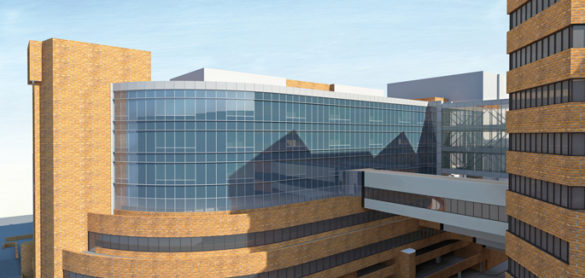
Later this fall, a new three-floor pedestrian bridge will be installed connecting the North Tower of Vanderbilt University Adult Hospital (VUAH) to Medical Center East (MCE)-North Tower. The new bridge will connect the two buildings on the sixth, seventh and eighth floors.
Installation of the new bridge will require the closure of the existing pedestrian bridges on the second, third and fourth floors for several hours on the days on which the new bridge structures are lifted into place. The pedestrian bridge on the fifth floor connecting VUAH to Medical Center East-South Tower is unaffected by the work and will remain open throughout.
Street closings in front of the hospital will also be necessary and will limit vehicle traffic, but pedestrians will have a walkway between the first floor of VUAH and the Central Garage across the street.
In order to reduce the effect on operations as much as possible, the days on which the work is performed affecting the existing bridges will occur over three weekends, currently scheduled Nov. 18, Dec. 2 and Dec. 9, said Janice Smith, R.N., M.Ed., Interim Chief Operating Officer for Ambulatory Services, Vanderbilt Hospitals and Clinics.
While the crane, which is necessary for the pedestrian bridge placements is being assembled and disassembled, Medical Center Drive will have severely reduced traffic — sometimes with full road closures except for ambulance traffic. Medical Center Drive will be closed to through traffic for about eight weeks, although access to the VUAH entrance and Emergency room will be maintained.
A committee representing affected areas of VUMC, chaired by Smith, is working to make sure that clinical operations and the employees affected have alternative work plans.
More detailed communications about the days, times and specifics of the work will be sent through MyVUMC and other means as plans are more firm.
The work on the bridges is the most visible evidence of the continuing work on MCE-North Tower.
Phase One of the project, which will convert the eighth floor of MCE-North Tower to inpatient beds, began in May and is planned for completion by early summer 2018, said Bobby Otten, assistant director of Space and Facilities Planning for Vanderbilt University Medical Center (VUMC).
The longer-range plan, which will similarly convert the sixth and seventh floors of MCE-North Tower to inpatient units, will begin in the second half of 2018.
“We’re looking at the end of 2019 for the completion of the whole project,” Otten said.
At that time — with the third floor housing operating rooms, the fourth floor being a postpartum unit for Labor and Delivery, the fifth floor housing the clinic for cardiovascular patients and connected to the cardiovascular floor on VUAH, in addition to the new inpatient areas on the sixth, seventh and eighth floors — MCE-North Tower will be tied much more closely to the functions of the hospital, said Donald Blair, VUMC’s long-term architect and a partner at the firm Blair + Mui Dowd.
The cost of doing this conversion is far less than would have been required to build the facility from the ground up, and will result in the net addition of 87 new patient beds for VUMC, Blair said.
The additional beds are necessary due to VUMC’s continued growth in both clinical programs and in the demand from patients who choose Vanderbilt as their provider.
The MCE-South Tower is unaffected by the plans, and the clinics and other facilities currently in MCE-North Tower will be relocated with plenty of notice to employees of those areas and patients.
In addition to the conversion of three floors to inpatient space, the project also includes upgrades to MCE-North Tower, including new heating and air conditioning units and a new, state-of-the-art glass exterior wall to replace the existing wall, which was original to the structure. MCE-North Tower was built in two phases, completed in 1991 and 1993.
The MCE-North Tower project was a Request for Proposal (RFP) process involving five construction management firms that have successfully completed similar complicated projects.
The five responding firms were Messer Construction, R.C. Mathews, Robins and Morton, Turner Construction Company, and Walsh Construction Company. The firms were graded on predefined criteria requested in their proposals, along with an interview process.
Robins and Morton was selected and is the project’s construction manager.












